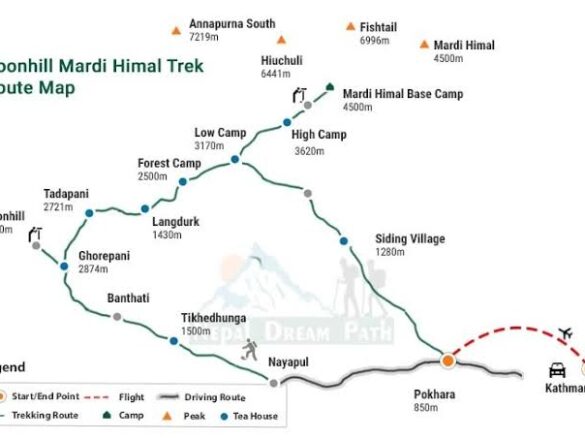This splendid trek, which combines stunning nature with unique culture, is the Mardi Himal and Ghorepani Pun Hill trek.
It takes approximately ten days to hike this route, which is why it makes sense to dedicate that much time to completing the Annapurna Circuit in your ideal itinerary in an ideal world; you will have the chance to experience the wonders of the mountains, villages, plants, and animals typical of the area.
The journey kicks off in Pokhara, a picturesque lakeside town and the starting point for many Himalayan treks. A great place to stock up on supplies and take it all in prior to trekking.
Day one involves a beautiful drive from Pokhara to Kande to kick off the trek. After Kande, the forests open up to rhododendron meadows leading to the picturesque village of Australian Camp with the Annapurna range views from the place.
The following day, the trek then leads to Pothana, where trekkers take pleasure in the colorful Gurung culture. The trek to Forest Camp continues, and the scenery changes displaying the diverse nature of the region.
The trail rises to a place called Low Camp, after spending a night in Forest Camp, and it is here that we start to get some of the stunning views of Mardi Himal.
Trek from Low Camp to High Camp through beautiful alpine meadows, and wonderful views of mountains. A day hike to the Mardi Himal Base Camp is commonly incorporated here, allowing you to get closer views of the unique mountain. This is a highlight of the trek with a sense of accomplishment and great views.
The itinerary shifts to the Ghorepani Poon Hill trek after the descent from Mardi Himal. Trekking leads trekkers through charming hamlets and terraced farmlands for more than a week to reach Ghorepani.
Ghorepani: Famous for Poon Hill Hike, One of the best viewpoints in the Annapurna region For sunrise aficionados, an early rise to Poon Hill allows gold dawn sunlight to light up the peaks of Dhaulagiri and Annapurna.
After this unforgettable moment, the trail takes you down to Tadapani, where you will be able to dig into the local culture. Further adrift, the trail takes you to Ghandruk, boasting another splendid Gurung village with an assortment of stone houses and cultural diversity.
From Ghandruk, trekkers will retrace their steps down towards Nayapul, where they will have a vehicle waiting to take them back to Pokhara.
This well-balanced itinerary not only allows for an exceptional trekking experience but also a cultural exploration of the region, offering trekkers a taste of the best of both worlds. Every day has its own story with places to explore, views to take in, and the hospitality of different communities.
All in all, both these treks are a right balance of challenge and beauty that you carry with you in your heart after the trek and it stays there with you till the time you live.
Introduction to the Itinerary
The Mardi Himal And Ghorepani Poon Hill Trek Itinerary is crafted to experience the natural scenery, culture, and melting challenges together in the best and most comprehensive ways.
The trek lasts about ten days and takes trekkers across some of the most incredible parts of the Annapurna mountain range, displaying many breathtaking valleys along with majestic peaks.
This trek is for everyone from experienced trekkers to first-timers on the trails, the trek is graded easy-moderate. Every day is carefully designed to connect with culture whilst hiking and connect with self whilst hiking.
This itinerary will allow the trekkers to experience all the biodiversity that the region has to offer – flora, fauna, and culture, with the bonuses of trekking companionship.
Along the way, trekkers are treated to stunning sunrises, delightful village visits, and local hospitality that make this adventure memorable.
Mardi Himal and Ghorepani Poon Hill Overview
This trek is one of the most beautiful Canadian treks that you can do, which is beautifully concluded with the grandeur of the Annapurna region of Nepal and its surroundings.
Pristine natural beauty is one of the highlights of the Mardi Himal trek, presenting magnificent views of Annapurna South, Machapuchare, and Mardi Himal. Being on this lesser-visited trail helps trekkers to lose themselves in the calm environment normally away from the regular trekking paths.
On the other hand, the Ghorepani Poon Hill route is known for its iconic viewpoint where sunrise illuminates the summits of the Annapurna and Dhaulagiri ranges.
Both tracks are filled with local communities and terraced fields with the beautiful colors of the rhododendron forests. The perfect mix of trekking for all trekking lovers who want both adventure and beauty when traveling to Nepal.
Day 1: Arrival in Pokhara
Mardi Himal Trek Cost Upon reaching Pokhara, trekkers will be welcomed by a beautiful lakeside city with a view of the Annapurna range and an abundance of life. Mainly this day we will be acclimatization, and preparing ourselves for the upcoming trek.
Once in Phewa Lake, visitors can relax in their lodgings, discover the local streets and shops, and dine on traditional Nepali food in one of the many eateries along the shore. There are numerous ways to unwind in the stunning scenery on the lake or by visiting the World Peace Pagoda for those so inclined.
The first day in Pokhara is a must because we need time to rest and adjust mentally to the adventure ahead of us. Trekkers can complete gear checks refill last-minute supplies, and meet fellow adventurers for social camaraderie before the trek begins.
Anticipating the trek ahead, the plans begin to materialize against the backdrop of a setting sun over the lake.
Day 2: Pokhara to Phedi & then Trek to Australian Camp
After an early morning drive from Pokhara, Day Two brings us to Phedi, the starting point for the trek. The drive in itself is a journey passing through the countryside where trekkers can see all the greenery and rural life of the country, Nepal.
The trek then begins from Phedi, a village with a 2-hour drive along with an increasing path going through, well-defined trails. Through quaint villages, terraced fields, and thick rhododendron forests, the trail meanders into views of local habitats and glorious natural scenery.
The journey to Australian Camp on the first day along the trail is about two to three hours and it sits at an elevation of around 2,060m. You get beautiful views of the surrounding mountains, including Annapurna and Machapuchare, from the Australian Camp itself.
Once trekkers check in at their lodges, they can spend the evening watching the beautiful sun setting and exchanging stories with other fellow trekkers amidst the serene Himalayan backdrop. It is a very special day and you can sense the beginning of the experience coming, a combination of physical activity, warm nature, and fellowship.
Day 03: Australian Camp to Landruk
Day three will see you walking from Australian Camp to Landruk, a traditional Annapurna village. Starting with a knee-slapping descent through green-covered paths and terraced paddy fields, it is a great way to see what local farmers are up to and catch a glimpse of their rustic lifestyle.
As the downward trail continues, trekkers are rewarded with beautiful views of the Modi Khola River and its surroundings. The fourth section of the trek generally will take four to five hours; sufficient time for time and to experience the environment.
Partway up the hill is the village ofLandruk, a lively Gurung village with stone houses and a peek into local village life. Available on Arrival Trekkers can explore the village, chat with locals, and eat a well-deserved meal at a local teahouse.
The warm hospitality of the villagers adds to the experience, as well as the insight into their customs and traditions. At the end of the day, they can relax and reflect on the beauty of the previous miles while spending time getting to know the landscape and the culture that makes this trek so spectacular.
Day 4: Landruk to Jhinu Danda
Day 4: From Landruk to Jhinu Danda for 5 to 6 hours of trekking. The trek starts with a downhill walk to the Modi Khola River, where a suspension bridge crosses the impressive gorge. The trail heads up through lush forests and terraced fields, giving you a taste of the local landscape and agriculture after crossing the river.
Trekking you might see a sight of the glorious Annapurna South from far away. After arriving at Jhinu Danda which has natural hot springs, trekkers can rest and soak in the natural hot water providing a nice way to relax after a long day of hiking.
The village is also a good place to taste local food and meet the locals. This sets the scene for what is a magical end to your day as you enjoy a stunning sunset painting the mountains with gold around you, one of the best experiences you can have in your evening in the Himalayas.
Day 5: Chhomrong – Jhinu Danda
Trek from Jhinu Danda to Chhomrong, covering a distance of six hours (day five) That day starts with a gentle climb that provides views of the hills and valleys of where we have been. The trek will be mostly undulating and will take trekkers through quaint little villages and terraced fields.
The trek continues towards the village of Chhomrong, which is located on a steep slope at an altitude of around 2,170 m. One of the important entry gates of Annapurna sanctuaryChhomrong, the beautiful place where you can look at showing of Annapurna south and other peaks.
Once there, trekkers are free to wander the settlement, buy trinkets from local stores, and meet the friendly Gurung people. ATMOSPHERE After that, you can spend the evening at a teahouse where you can taste local delicacies, with a sunset view over beautiful mountains.
While day three not only pushes trekkers physically, it also adds culture, as Chhomrong is a bustling center for local life and culture.
Day 6: Chhomrong to Bamboo
Day six: Chhomrong to Bamboo (4–5 hours) This is an easier walk. Starting steeply downward from Chhomrong, It leads down through stone steps that open the views of wonderful green valleys.
After this, the trail passes along the Chhomrong Khola, meandering through bamboo and rhododendrons, ensuring a peaceful experience. The trek is not only what makes it beautiful, but somehow when you are trekking in the Annapurna region, you will also have the opportunity to observe various species of plants and animals on the way.
From there, the trek to Bamboo — which is about 2,310m up, is a gradual ascent, and each step gets more and more fulfilling as the goal is gradually approaching. First, of course, is the arrival, where the setting is docile with the whispering of flowing waters, and birds chirping.
The teahouses offer simple comfort for trekkers, it is an ideal place to unwind and to reflect on the journey up to this point, backdropped by the majestic Himalayas.
Day 7: From Bamboo to the base camp of Mardi Himal
Day seven is by far the best day of the trek where trekkers will hike from Bamboo to Mardi Himal Base Camp, a trek that takes around six to seven hours. As the trail ascends through beautiful woodland, the sounds of wildlife fill hikers ears, and the aroma of pine wafts through the air.
View of Machapuchare and Mardi Himal from the trail — trekkers are treated to more and more spectacular views as they climb perchè virale speed camera. The last few steps to the Base Camp have very rough, less covered natural phenomena and end at a view that is worthy of all the effort.
After experiencing all the thousand reasons why you would fall in love with this nature trek at the Mardi Himal Base Camp where a height of roughly 4,500 meters exists, trekkers can reflect on all the beauty that the Himalayas has to offer while gloating over this success.
It is this remote, serene environment that provides the ideal background for contemplation and appreciation of nature. Hiking enthusiasts can pitch tents, savor a hot meal, and savor a spectacular sunset that will color the peaks with brilliant shades and mark the close of an extraordinary day.
Day 8: From Base Camp of Mardi Himal to Low Camp
Day 8: Mardi Himal Base Camp to Low Camp On the eighth day, trekkers return from Mardi Himal Base Camp down to Low Camp, an approximately four to five-hour trek. On the way back trekkers retrace their steps back through sweeping valleys passed on the way up, but this time with a new perspective.
The descent down the rocky ground includes some magnificent views of the different shadows being drawn over the face of the mountains by the sun. Low Camp is a great place for trekkers to sit back and soak up the peaceful environment.
At the Base Camp, the altitude is harsh, but this lower elevation is much nicer and cozy. You can spend the evening swapping tales with other trekkers, filling your stomach with wholesome meals, and enjoying breathtaking views.
The return allows one to recover physically and contemplate on the epic travel through the Himalayas, yielding a sense of accomplishment, yet anticipation for what lies ahead on the journey.
Day 9: Low Camp to High Camp
Day nine: After Low Camp, trekkers move onward to High Camp — a trek of approximately three to four hours. It twists its way through magical woods and provides distant views of majestic mountains.
While many portions of the trek are densely wooded, as trekkers ascend they will encounter sparser, more open areas with breathtaking views of Annapurna and the iconic peak of Mardi Himal.
We start from base camp at High Camp (around 4,200m), the ideal launch pad for anyone wanting to reach Libra that leads you towards the Mardi Himal Base Camp. When you reach this point, trekkers have the opportunity to take a breather, eat a warm meal, and enjoy the views.
The tranquility at High Camp is perfect for unwinding and getting ready for the summit push tomorrow. With shades of pink and reds cooling into the evening sky, this time of sunset is ideal for any affectations of taking photos, and as a time of reflection on the day thus far.
Day 10: High Camp to Mardi Himal and back
The trekking day, day ten is an absolute highlight, taking trekkers on a day hike from the High Camp to Mardi Himal Base Camp. The Base Camp trek usually takes about three to four hours and winds through rocky landscapes and alpine meadows.
The views get more and more incredible as backpackers climb, with the massive summits of the Annapurna range revealing itself in full view. Trekkers can indulge in captivating views as they reach Mardi Himal Base Camp at 4,500m, relishing a refreshing breather in this nature-filled gem.
Further enhancing the moment is the majestic view of Machapuchare, more commonly known as Fish Tail. Trekking back to High Camp will take some time and give travelers a chance to reflect on the events of the day and be at peace with it.
This day is a highlight of the trip, the sense of accomplishment meeting the beauty of what surrounds you.
Day 11: High Camp to Sidding & Drive to Pokhara
Day eleven: From High Camp, trekkers make the journey to Sidding, which takes roughly six to seven hours. It also provides a wonderful opportunity to see the beautiful scenery from below in the morning sunlight as the light hits the valley and mountains.
Sidding, The trail passes through dense forests and terraced fields up to the village of Sidding, which gives you insights into local life. Trekkers will stop in Sidding for food and a short rest before making this trek’s final ascent. Then they will have a 2-hour drive back to Pokhara.
This journey back gives you a mini chance to reminisce upon some of the best moments of the trek, the challenges, the sights, and the friendly local people you meet along the way. Today trekkers arrive in Pokhara, where they can rest, have a lakeside meal, and swap tales with other adventurers about their time in the Himalayas.
Day 12: Pokhara to Ghorepani
Day twelve: Trekking from Pokhara to Ghorepani, on an approach to yet another classic section through the Annapurna region. Your first day to experience the trek begins with a drive from Pokhara to Nayapul, from Nayapul we will go hiking to Tikhedhunga.
The trekkers rest for a while and resume their hike to Ghorepani after taking a short break which normally takes six to seven hours. It is a trail that comprises colorful terraced fields and lush green rhododendron forests, surreal if trekked in the spring season.
When they make it to Ghorepani at about 2,850 meters, hikers are rewarded with incredible views of Dhaulagiri and the Annapurna range. Ghorepani is a busy village, famous for its hospitality and a common place for trekkers to rest.
This is also the place where the trekkers can taste local foods and prepare for the fun-filled sunrise trek to Poon Hill next morning, eager to see stunning views of them.
Day 13: Ghorepani Sunrise Tour to Poon Hill, Trek to Tadapani
Day thirteen is an early morning with trekkers rising before the crack of dawn to make their way to Poon Hill, a famous vantage point that provides a stunning sunrise view.
It takes around half an hour to reach Poon Hill, where sunrise gives such golden colors to the Annapurna and Dhaulagiri ranges that the views become extraordinary.
For many on the trek, this moment is the highlight of the trek and the perfect time for snapping pictures and contemplating life. Upon re-experiencing the great views, the trekkers return to Ghorepani for breakfast and continue their travel at the Tadapani course.
The journey from Ghandruk to Tadapani is typically a six-hour hike through lovely rhododendron forests that provide scenic views of the mountains. Although trekkers arrive in Tadapani able to relax and soak in its beautiful scenery (which often features views of Annapurna South), After a day of exploration and adventure, the village delivers a cozy ambiance.
Day 14: Tadapani to Ghandruk
Day fourteen: The trek from Tadapani to Ghandruk takes only four to five hours, making it a short trip compared to other days’ trek. The trail winds down through dense tree areas and terraced fields; it is quiet and peaceful, so the only thing trekkers can hear is nature.
The trek provides excellent glimpses of the Annapurna range as you walk through trees. Ghandruk–Ghandruk is an old Gurung community famous for its culture and customs.
When they reach the village, trekkers can roam around the wooden shanties, check out the village museum, and chat with the friendly locals to understand their lifestyle. You can also taste local food in this village while enjoying a delicious dining experience.
With the sunset views over the mountains in the background as the day comes to an end, trekkers will find the conclusion of the day over the adventures of the trek, a rewarding experience before they retire for the night.
Day 15: Ghandruk to Nayapul & Back to Pokhara
The final trek, day fifteen, is the six-hour hike from Ghandruk to Nayapul. This trek is full of natural beauty and terraced fields and it is a beautiful farewell to the trek as it ends with the Annapurna range.
Nayapul is where trekkers can look back on their incredible journey amidst spectacular views and wonderful culture. They make their way back to Pokhara, and the adventure is at an end after a short drive. This last leg is all about taking it easy and enjoying the achievements made along the trek.
Well, Pokhara – is where trekkers can relax, possibly stroll around the lake, devour the local specialties, and browse the shops for gifts from the trek. The endpoint of this adventure time during the trek is in the hearts of trekkers like you forever.
Conclusion: A Map of Your Own Writing
With an element of trekking challenge, warm hospitality, unforgettable views, and cultural discoveries, the Mardi Himal provides unparalleled diversity in a single route.
Daily adventures await, with stunning sunrises, peaceful village encounters, and a collection of memories that trekkers take home reminiscing way after the trail finishes. This well-designed schedule offers an equilibrium of examination and contemplation for them to revel in the splendor and repose of the Himalayas.
This itinerary is a general overview, but the specialty of the trek is its flexibility, whether you can talk to local people on your way or sit quietly somewhere in nature to listen to what can nature say to you.
At the end of this expedition, the process is not in reaching a place but in travel, in ties you make, in regard to the wonderful nature of the Himalayas.



